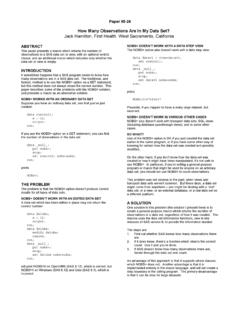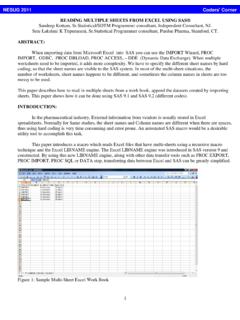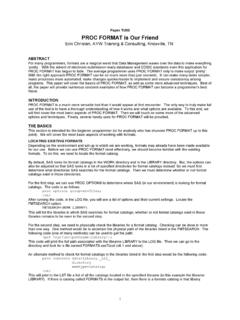Transcription of 081-2011: Building Match Code Using SAS®
1 1 Paper 081- 2011 Building Match code Using SAS David Li, Prime Therapeutics, Eagan, MN, United States ABSTRACT Business analysis frequently entails joining data from different sources. Oftentimes, the linkage must be made based on a customer s name and address data. A SAS name and address Match code can accomplish this task and move the project forward without interruption. This paper highlights three concepts: (1) modular design, (2) looped sequential processing, and (3) the parsing of data elements. SAS macros can compactly implement the basic Match code . They organize the code modules and perform a sequence of tasks against a single input record at a time. Macros also manipulate the parsing and transforming of text strings into the final Match code . The programming techniques necessary to move a data element through the various stages are discussed in detail.
2 This paper details the process of parsing a sub element from a specific variable of a data set, converting a data set variable into a macro variable, and storing a macro variable value as a record within a data set, and provides other useful tips as well. INTRODUCTION Business analysis is employed in many different sectors to forecast customer behavior. In the retail sector, merchants attempt to predict which customers will make another purchase. Telecom carriers want to know which subscribers will churn (cancel service). In healthcare, pharmacy benefit managers (PBMs) want to identify which members will use the mail channel to fill their prescriptions. All of these businesses need a great deal of information about their customers to build the best predictive models. Analytics cannot take place without data.
3 Grouping all relevant information about a customer is an important data management activity. The bulk of the information for analysis usually comes from internal transaction data. However, some external data are very predictive. The insurance industry s use of credit information to predict driver behavior is a prime example. Name and address matching is frequently utilized to link information from diverse sources. Once disparate customer information has been joined, it can be analyzed Using a universal customer identifier. Similar examples of the need for comprehensive customer data are readily found in banking, nonprofits, and other industries. Accurate customer data is needed not only for analytics, but also for operational efficiency in customer service centers, the creation of customized marketing messages, modeling of customer lifetime values, and mailing of confidential health information.
4 Finally, the combined data set yields an information value greater than the sum of its parts. High value analytic processes such as predictive modeling, forecasting, and healthcare benefit design are all ravenous consumers of data. THE BASIC CONCEPT Match code creates a standard view for different renderings of the same information. Its algorithm must account for different name and address formats and deal with transcribing errors. The probability of a correct Match is increased by focusing on the initial of the last name, the numeric part of the address, and the 5-digit zip code . The general matching process is described as follows: 1. Count the number of records in an input file. 2. Loop through the input file and process each record individually. 3. Convert specific variable values in the record into macro variables.
5 4. Modify the macro variables in accordance with the Match code logic. 5. Combine components into one Match code per record. 6. Save the Match code results to the output file. 7. Repeat the sequence for all input files. 8. Join the different data files Using the Match code . The Match code Building process starts with two or more differing customer data files. Each of these files contains Coders' CornerSASG lobalForum2011 Building Match code Using SAS , continued 2 some non-overlapping information that we wish to combine to create a new view of the customer. To Match the files based on name and address, last name (LastName), address (Address), and zip code (ZipCd) are used to build the Match code . These three data elements allow accurate matching at the household level. Additional data fields may be needed to link the generated Match code to other data tables.
6 A sample input file may look like the data table below. LastName ZipCD Address UniqueID LANE 55408 3241 E CALHOUN CIRCLE 001 SMITH 55666 12584 PARK AVE 002 Table 1. Sample input data file A data preparation step is needed here, so that the letters are all capitalized and special characters removed. It is considerably easier to prepare the data as a separate step than to try and anticipate all possible variations. Building MACRO MODULES To implement the Match code algorithm, macro modules are first sketched out Using pseudo code . From an initial rough outline, details are iteratively developed to refine the coding tasks. The design of the main macro module greatly influences the fit of the other components. This code starts by determining how many times to call a yet unknown process, process each record, to create the Match code .
7 Then it stores the returned values. %macro MatchBld(dsin, dsout); Count the number of records (N). Create a do loop to process the input file N times. Process each record. Create a temporary table, once, to hold the processed outputs. Insert data into the temporary table one record at a time. End do loop. Create the output data set containing the final Match code . %mend; Once the programming logics have been worked out in the pseudo code , SAS coding can begin. The %MatchBld ( Match code Build) macro obtains two pieces of information from its macro parameters. The input data set name (dsin or data set in) tells the program where to find the name and address data for processing. The output data set name (dsout or data set out) tells it where to write the results of the newly created Match code .
8 The SQL Procedure s SELECT INTO statement is used to produce a count of how many records are in the input data set. It converts the count from a descriptive statistic into a value held by a macro variable, NCNT. The NOPRINT option is chosen to prevent the default output from being displayed. NCNT tells the Do Loop how many times to call the macro that will process each record. The LastName and Address variables are modified separately and then stored together in an output data set. We will cover these processes in more depth later. The Match code is designed to process each record sequentially. In each sequence, it transforms three (3) different input variables into a single Match code variable. The %ObsLp (Observation Loop) macro is used to process each record. It routes the variables through additional macro modules that modify the different input variables into Match code components.
9 The modified results are returned to the main macro, %MatchBld, for final assembly. A temporary data table is created when %MatchBld s Do Loop is executed. To create the table only once, the macro statement %IF, %THEN and %ELSE is applied to branch off the first pass-through, where the table creation takes place. After the first pass, the INSERT INTO SQL statement saves the modified LastName and Street Address values. It also converts the macro variables &LNCSTNT and &ADDRCSTNT back into variable values to be stored as a data file record. Coders' CornerSASG lobalForum2011 Building Match code Using SAS , continued 3 %macro MatchBld(dsin, dsout); proc sql noprint; select count(*) into:NCNT from quit; %do i=1 %to %ObsLp(&dsin, %if &I=1 %then %do; proc sql noprint; create table MODWORD (LNCSTNT char(32), ADDRCSTNT char(200)); insert into MODWORD values("&LNCSTNT", "&ADDRCSTNT"); quit; %end; %else %if &I>1 %then %do; proc sql noprint; insert into MODWORD values("&LNCSTNT", "&ADDRCSTNT"); quit; %end; %end.)
10 (Additional data step statements) . %mend; LOOPED SEQUENTIAL PROCESSING Only two of the three input variables, LastName and Address, need to be modified for the Match code . The 5-digit zip code , ZipCd, is incorporated into the Match code as is, for a specific name, address, and zip code combination. Therefore, when creating macro variables from data set variables, our code design calls for LastName and Address to be the first step in the looped sequential processing. These transformation tasks are coordinated by the looping macro, %ObsLp. CREATING MACRO VARIABLES Since this Match code algorithm is written in SAS Macro, it needs to be able to transition seamlessly between SAS data set variables and SAS macro variables. It creates macro variables from the data set and other inputs through four common macro variable creation methods: 1.














